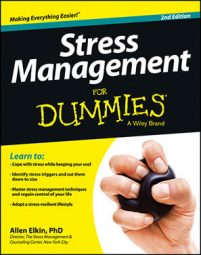One of the better relaxation techniques for relieving stress derives from a method called progressive relaxation or deep-muscle relaxation. This method is based on the notion that you’re not aware of what your muscles feel like when they’re tensed. By purposely tensing your muscles, you’re able to recognize what tension feels like and identify which muscles are creating that tension.
You begin progressive relaxation by tensing a specific muscle or group of muscles (your arms, legs, shoulders, and so on). You notice the way the tension feels. You hold that tension for about ten seconds, and then let it go, replacing that tension with something much more pleasant — relaxation.
By the time you tense and relax most of your major muscle groups, you feel relaxed, at peace, and much less stressed. The following general guidelines set the stage for muscle-group-specific relaxation techniques.
Lie down or sit, as comfortably as you can, and close your eyes.
Find a quiet, dimly lit place that gives you some privacy, at least for a while.
Tense the muscles of a particular body part.
To practice, start by tensing your right hand and arm. Begin by simply making a fist. As you clench your fist, notice the tension and strain in your hand and forearm. Without releasing that tension, bend your right arm and flex your bicep, making a muscle the way you might to impress the kids in the schoolyard.
Don’t strain yourself in any of these muscle-tensing maneuvers; don’t overdo it. When you tense a muscle group, don’t tense as hard as you can. Tense to about 75 percent of what you can do. If you feel pain or soreness, ease up on the tension, and if you still hurt, defer your practice till another time.
Hold the tension in the body part for about seven seconds.
Let go of the tension quickly, letting the muscles go limp.
Notice the difference in the way your hand and arm feel. Notice the difference between the sensations of tension and those of relaxation. Let these feelings of relaxation deepen for about 30 seconds.
Repeat Steps 1 through 4, using the same muscle group.
Move to another muscle group.
Simply repeat Steps 1 through 4, substituting a different muscle group each time. Continue with your left hand and arm, and then work your way through the major muscle groups.
Relaxing your face and head
Wrinkle your forehead (creating all those lines that everybody hates) by raising your eyebrows as high as you can. Hold this tension for about five seconds, and then let go, releasing all of the tension in your forehead. Just let your forehead muscles become smooth. Notice the difference between the feelings of tension you felt and the more pleasant feelings of relaxation.
Now clench your jaw by biting down on your back teeth. At the same time, force a smile. Hold this uncomfortable position for about five seconds, and then relax your jaw, letting your mouth fall slightly ajar.
Finally, purse your lips, pushing them together firmly. Hold that tension for a bit, and then relax, letting your lips open slightly. Notice how relaxed your face and head feel. Enjoy this sensation and let this feeling deepen by letting go of any remaining sources of tension around your mouth and lips.
Relaxing your neck and shoulders
Bend your head forward as though you’re going to touch your chest with your chin (you probably will). Feel the tension in the muscles of your neck. Hold that tension. Now tilt your head slightly, first to one side and then to another. Notice the tension at the side of your neck as you do so.
Tilt your head back as if you’re trying to touch your upper back. But don’t force it or overdo it, stopping if you notice any pain and discomfort. Now relax, letting your head return to a more comfortable, natural position. Enjoy the relaxation for a moment or so.
Now scrunch up your shoulders as though you’re trying to reach your ears. Hold it, feel the tension (again for about five seconds), and let your shoulders fall to a comfortable, relaxed position. Notice the feelings of relaxation that are spreading through your shoulders and neck.
Relaxing your back
Arch your back, being careful not to overdo it. Hold that tension for several seconds, and then let your back and shoulders return to a more comfortable, relaxed position.
Relaxing your legs and feet
Either sitting or lying down, raise your right foot so that you feel some tension in your thigh and buttock. At the same time, push your heel out and point your toes toward your head, as shown in this figure.
![[Credit: Illustration by Pam Tanzey]](https://www.dummies.com/wp-content/uploads/382047.image0.jpg)
Hold this tension, notice what it feels like, and then let go, letting your leg fall to the bed or floor, releasing any remaining tension. Let that relaxation deepen for a while. Repeat this sequence with your other leg and foot.
Relaxing your buttocks
Tense the muscles of your buttocks, noticing what that feels like. Hold that tension for several seconds. Slowly release that muscle tension, letting go, letting the muscles in your buttocks gently release. Notice those feelings of relaxation and let them deepen even further.
Relaxing your stomach
Take in a deep breath and hold that breath, tensing the muscles in your stomach. Imagine that you’re preparing yourself for a punch in the stomach. Hold that tension. And relax, letting go of the tension.
After you finish this sequence, let your body sink into an even deeper state of relaxation. Let go more and more. Mentally go over the sensations you’re feeling in your arms, face, neck, shoulders, back, stomach, and legs. Feel your body becoming looser and more relaxed. Savor the feeling.

